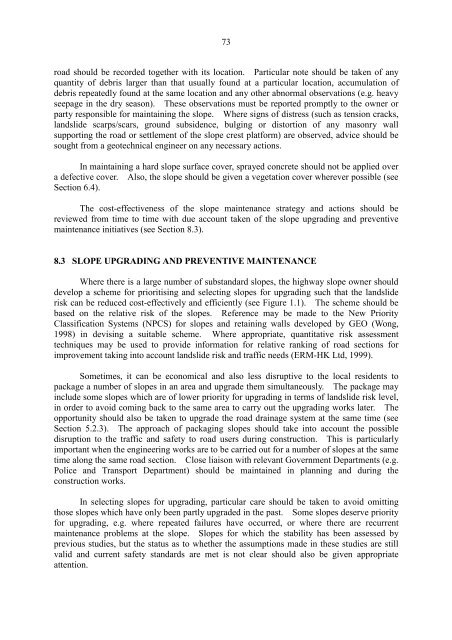Highway Slope Manual
Highway Slope Manual
Highway Slope Manual
You also want an ePaper? Increase the reach of your titles
YUMPU automatically turns print PDFs into web optimized ePapers that Google loves.
73<br />
road should be recorded together with its location. Particular note should be taken of any<br />
quantity of debris larger than that usually found at a particular location, accumulation of<br />
debris repeatedly found at the same location and any other abnormal observations (e.g. heavy<br />
seepage in the dry season). These observations must be reported promptly to the owner or<br />
party responsible for maintaining the slope. Where signs of distress (such as tension cracks,<br />
landslide scarps/scars, ground subsidence, bulging or distortion of any masonry wall<br />
supporting the road or settlement of the slope crest platform) are observed, advice should be<br />
sought from a geotechnical engineer on any necessary actions.<br />
In maintaining a hard slope surface cover, sprayed concrete should not be applied over<br />
a defective cover. Also, the slope should be given a vegetation cover wherever possible (see<br />
Section 6.4).<br />
The cost-effectiveness of the slope maintenance strategy and actions should be<br />
reviewed from time to time with due account taken of the slope upgrading and preventive<br />
maintenance initiatives (see Section 8.3).<br />
8.3 SLOPE UPGRADING AND PREVENTIVE MAINTENANCE<br />
Where there is a large number of substandard slopes, the highway slope owner should<br />
develop a scheme for prioritising and selecting slopes for upgrading such that the landslide<br />
risk can be reduced cost-effectively and efficiently (see Figure 1.1). The scheme should be<br />
based on the relative risk of the slopes. Reference may be made to the New Priority<br />
Classification Systems (NPCS) for slopes and retaining walls developed by GEO (Wong,<br />
1998) in devising a suitable scheme. Where appropriate, quantitative risk assessment<br />
techniques may be used to provide information for relative ranking of road sections for<br />
improvement taking into account landslide risk and traffic needs (ERM-HK Ltd, 1999).<br />
Sometimes, it can be economical and also less disruptive to the local residents to<br />
package a number of slopes in an area and upgrade them simultaneously. The package may<br />
include some slopes which are of lower priority for upgrading in terms of landslide risk level,<br />
in order to avoid coming back to the same area to carry out the upgrading works later. The<br />
opportunity should also be taken to upgrade the road drainage system at the same time (see<br />
Section 5.2.3). The approach of packaging slopes should take into account the possible<br />
disruption to the traffic and safety to road users during construction. This is particularly<br />
important when the engineering works are to be carried out for a number of slopes at the same<br />
time along the same road section. Close liaison with relevant Government Departments (e.g.<br />
Police and Transport Department) should be maintained in planning and during the<br />
construction works.<br />
In selecting slopes for upgrading, particular care should be taken to avoid omitting<br />
those slopes which have only been partly upgraded in the past. Some slopes deserve priority<br />
for upgrading, e.g. where repeated failures have occurred, or where there are recurrent<br />
maintenance problems at the slope. <strong>Slope</strong>s for which the stability has been assessed by<br />
previous studies, but the status as to whether the assumptions made in these studies are still<br />
valid and current safety standards are met is not clear should also be given appropriate<br />
attention.

















